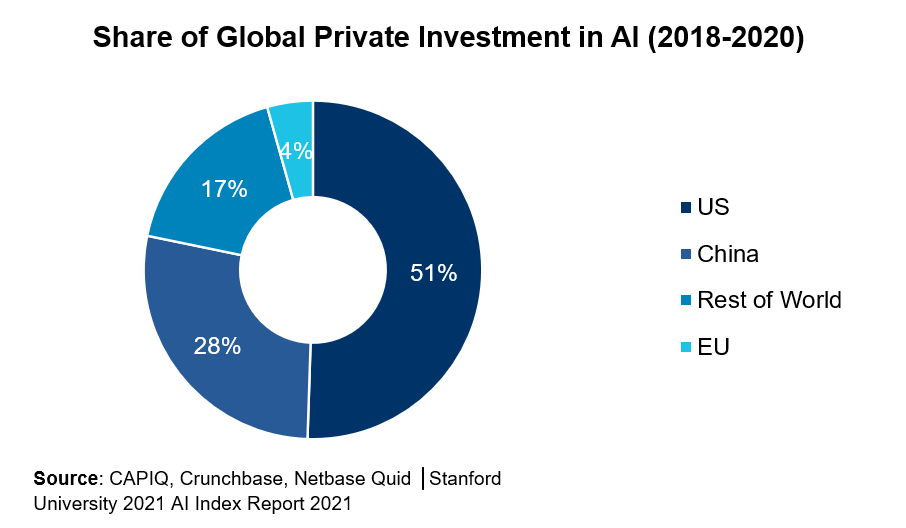Ungated Post | 19 Jul 2021
Standing on the shoulders of AI giants: An economic dividend for Asian economies

James Lambert
Director of Economic Consulting, Asia

In the race to become the leader in Artificial Intelligence (AI), China and the United States are way ahead of the global competition. What does that mean for everyone else? Will these two giants of the global technology industry soak up the AI economic dividend all for themselves?
The answer is no: There is a huge opportunity for smaller, agile economies in Asia to—as 17th century scientist Isaac Newton once said—“stand on the shoulders of giants” to reap the benefits of AI application in their own industries.
 Of course, it’s right to recognise the supremacy of the US and China. Together they account for more than two-thirds of private investment into AI taking place around the world (Fig. 1).
Of course, it’s right to recognise the supremacy of the US and China. Together they account for more than two-thirds of private investment into AI taking place around the world (Fig. 1).
The AI research infrastructure that these two countries have established has translated into an unassailable advantage over other nations in Europe, North America, and Asia. This is due to a number of factors: the depth of their capital markets, the richness of their skills bases, the dominant position of their cash-rich technology firms, and the data generation capacity of their vast populations.
However, the economic dividends from AI are not reserved for the researchers. The majority of economic value promised by the AI revolution will be captured through innovation and application of AI technologies in industry. Enterprises and policymakers the world over should recognise that the AI dividend is theirs for the taking.
AI is a fundamentally open science. It is fierce, open competition in academia and among businesses that drives global research forward. The relatively open borders to data flows and digital services mean the latest technological breakthroughs in one part of the world are quite quickly made available—and adaptable—to businesses everywhere else.
When it comes to AI application in industry, ambitious leaders can learn lessons from China’s achievements. China has managed to establish a culture of technology adoption and data sharing in consumer interactions and business practices that give it a distinct edge.
There are three factors behind this. The first is the openness within Chinese businesses to technological trial and error. Chinese enterprises have demonstrated a fundamentally positive and flexible attitude to digital solutions in the past two decades, which serve to accelerate AI integration and innovation. International executive surveys, such as the WEF Future of Jobs report, consistently rank China first in the world—or close to it —for their attitude to AI adoption.
The second factor is a robust and ambitious policy framework. China’s most recent five-year plan crystalised the national goal of “deep integration” of the internet, big data, and AI into various industries. More recently, the Chinese government has begun to tighten regulation on AI development and internet companies, but the repercussions of China’s broadly positive policy footing can be seen in the rate of investment taking place. The publicly funded, $2.1 Billion AI-focused technology research park on the outskirts of Beijing is one example. More broadly, as we explained in our recent study, How Robots Change the World, China accounts for almost 40% of new industrial robot installations globally, more than three times higher than second-place Japan.
Thirdly, China has established a world-class skills base, not only to develop AI solutions but to integrate them into industry, too. The rapid expansion of China’s pool of computer science and engineering graduates in recent years has been a core pillar of economic planning. China ranks third in the world for “AI skills penetration,” according to Stanford University’s AI Index report. That means AI skills are 1.4 times more likely to be required in Chinese occupations than the global average.
These three conditions create a virtuous cycle in China. A rapidly growing industry of Chinese firms is bringing AI products to market and competing to pursue AI solutions that are customised to Chinese situations. These solutions are embraced by receptive businesses, willing to quickly test, adopt, and integrate AI products into their operations. In doing so, they generate vast amounts of data, which allows developers to constantly and nimbly improve their AI products. This leads to innovative “spillover” applications in different industries—from finance to commerce, education, manufacturing and healthcare.
What’s more, the growing domestic market justifies high levels of investment in the tech industry. The openness to AI across the wider economy is indirectly fuelling Chinese innovation in high-tech computer chip manufacturing and software development.
Other Asian nations can benefit from China’s recent experience in AI, in pursuing their own virtuous cycle of AI integration. That means cultivating an open attitude towards AI adoption and integration within industry, emphasising technology skills development and retention, as well as being open to foreign investment and technology trade. Chinese technology firms are major sources of funding for tech entrepreneurship in the wider Asia continent, which itself leads to valuable knowledge spillovers around the region.
The AI economic dividend is not a prize being fought over by two international heavyweights—it’s a universal economic opportunity that all Asian nations can pursue; one which will shape the competitive landscape across the region over the next decade.
N.B. A version of this article was published on 13 July 2021 in the China Daily and Singapore Business Times.
Tags:
You may be interested in

Post
Taiwan earthquake hit local chip production, but only temporarily
Taiwan was hit by the 7.2 magnitude earthquake on 3 April, the strongest in 25 years. However, the economic impact seems to be manageable so far, thanks to sparse population close to the epicentre, improving building codes and stronger disaster management and awareness in the past two decades.
Find Out More
Post
Greenomics – Ep. 9 | The nature of Travel & Tourism
A discussion of the crucial role of climate-ready buildings in the global push towards a net-zero future. They delve into sustainable construction practices, the importance of regulations, retrofitting existing buildings, and behavioural changes to create environmentally friendly homes. The conversation also touches on the economic challenges and choices associated with transitioning to sustainable living.
Find Out More
Post
Offices globally the most exposed CRE sector to generative AI
We expect that offices will be the most exposed US property sector to the impact of generative AI by 2032, followed by life sciences and manufacturing. In contrast, the hospitality and industrial sectors look set to be the least exposed.
Find Out More